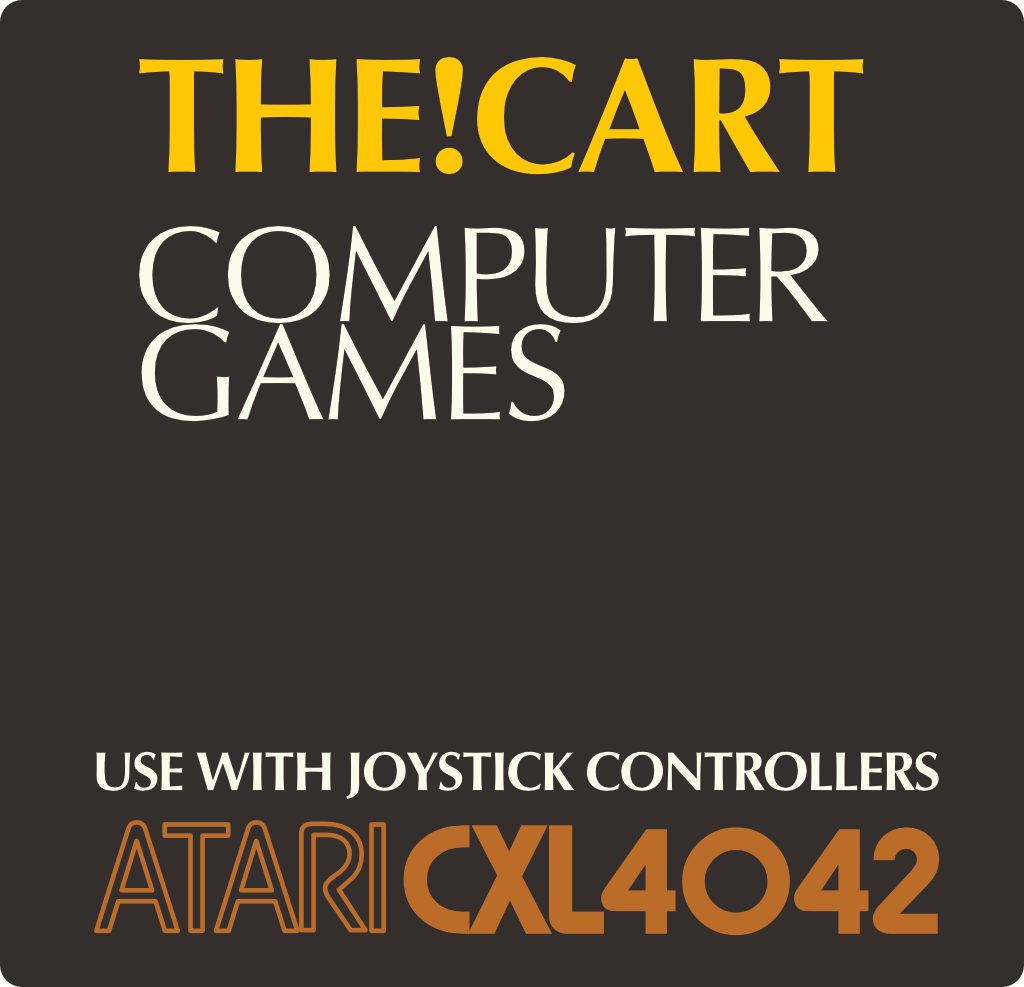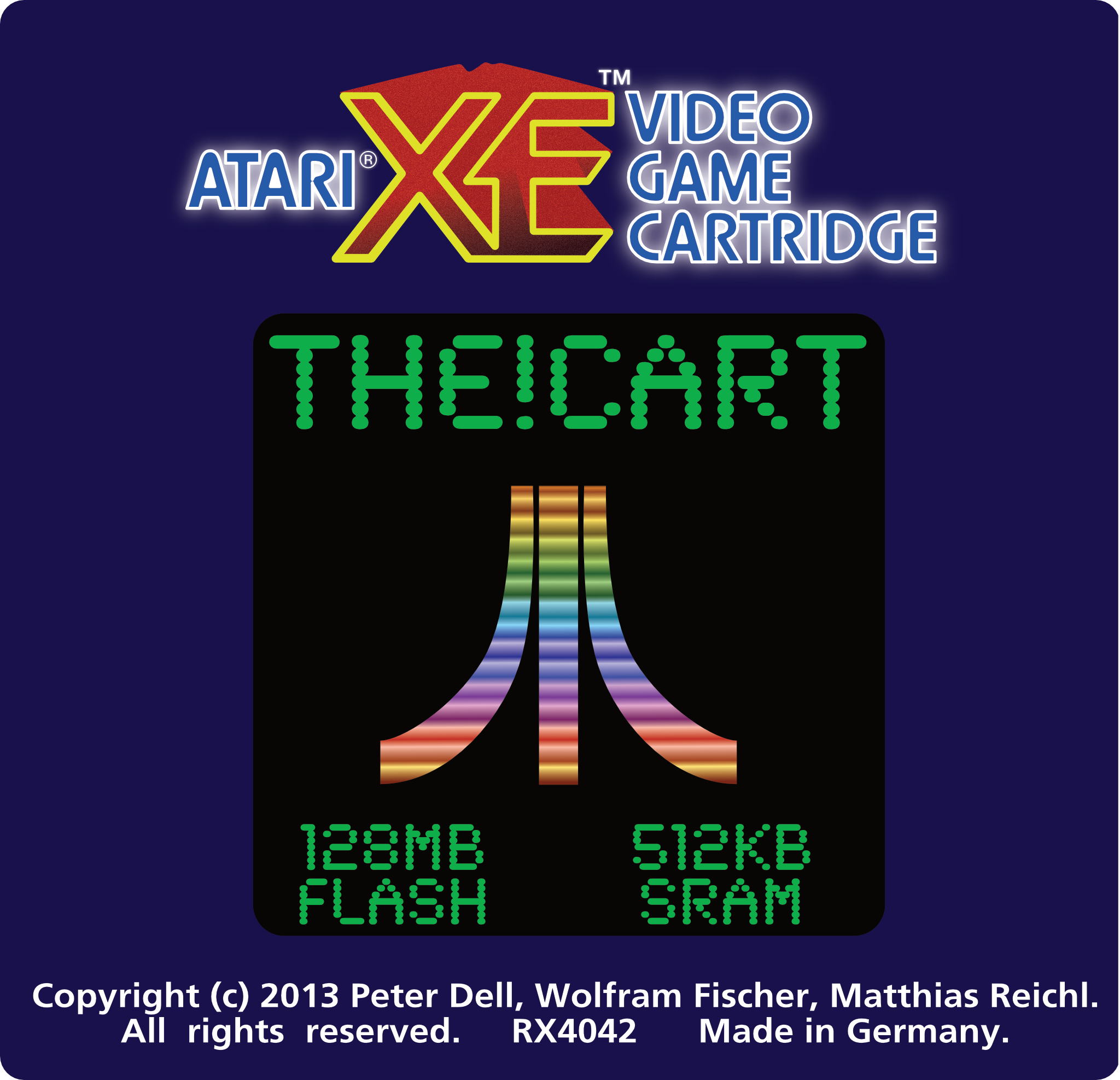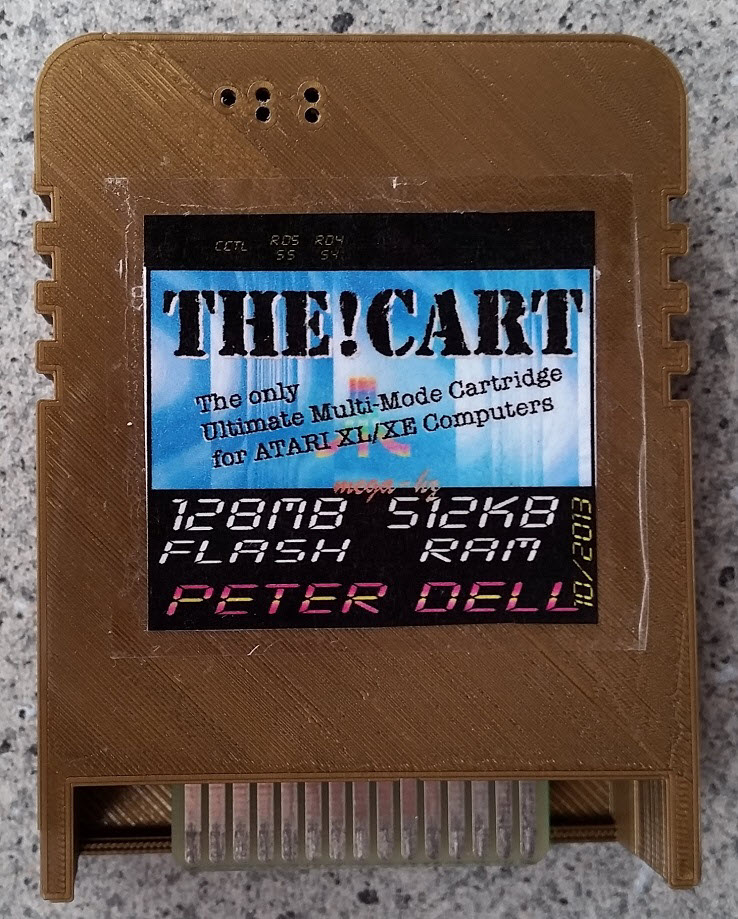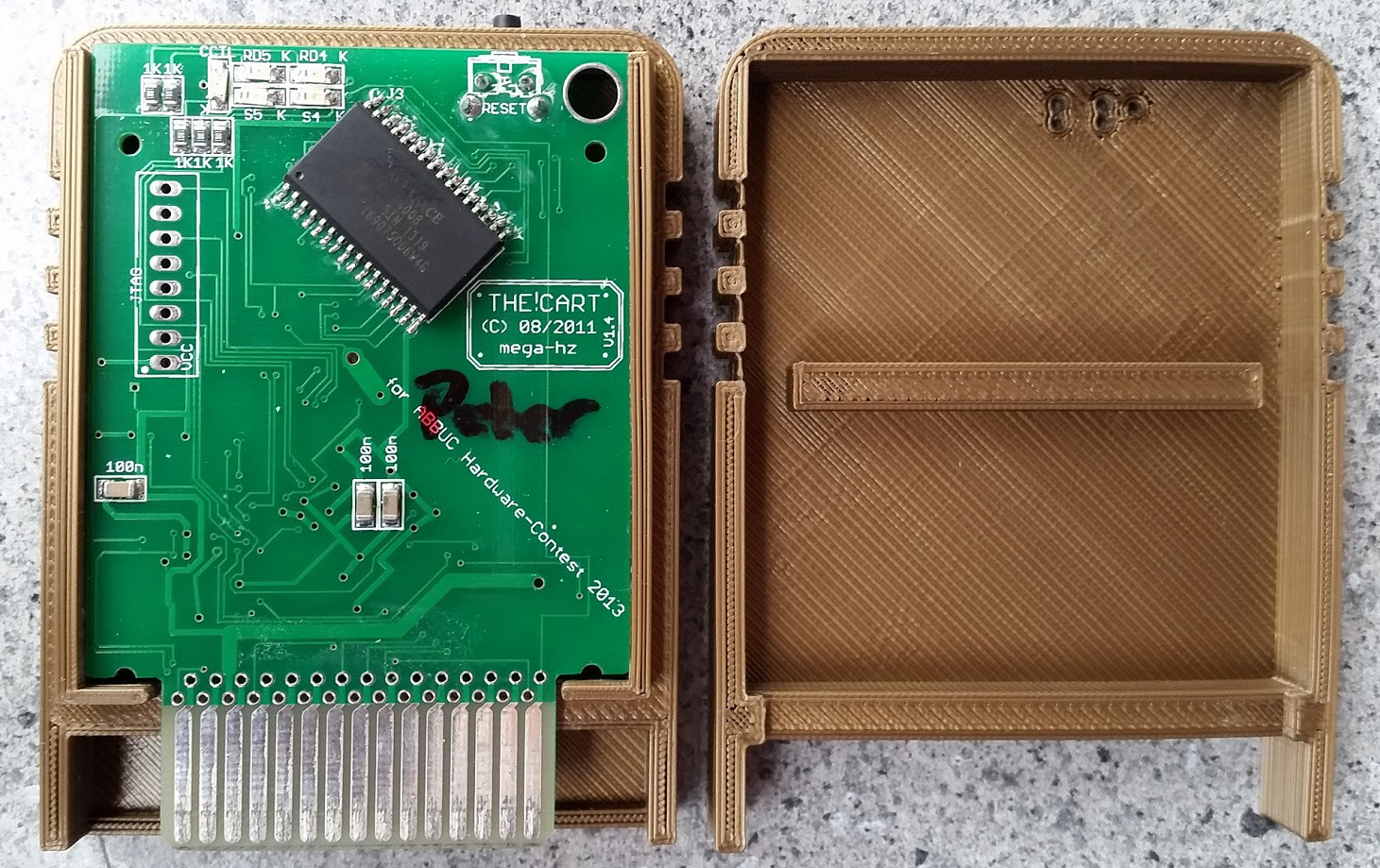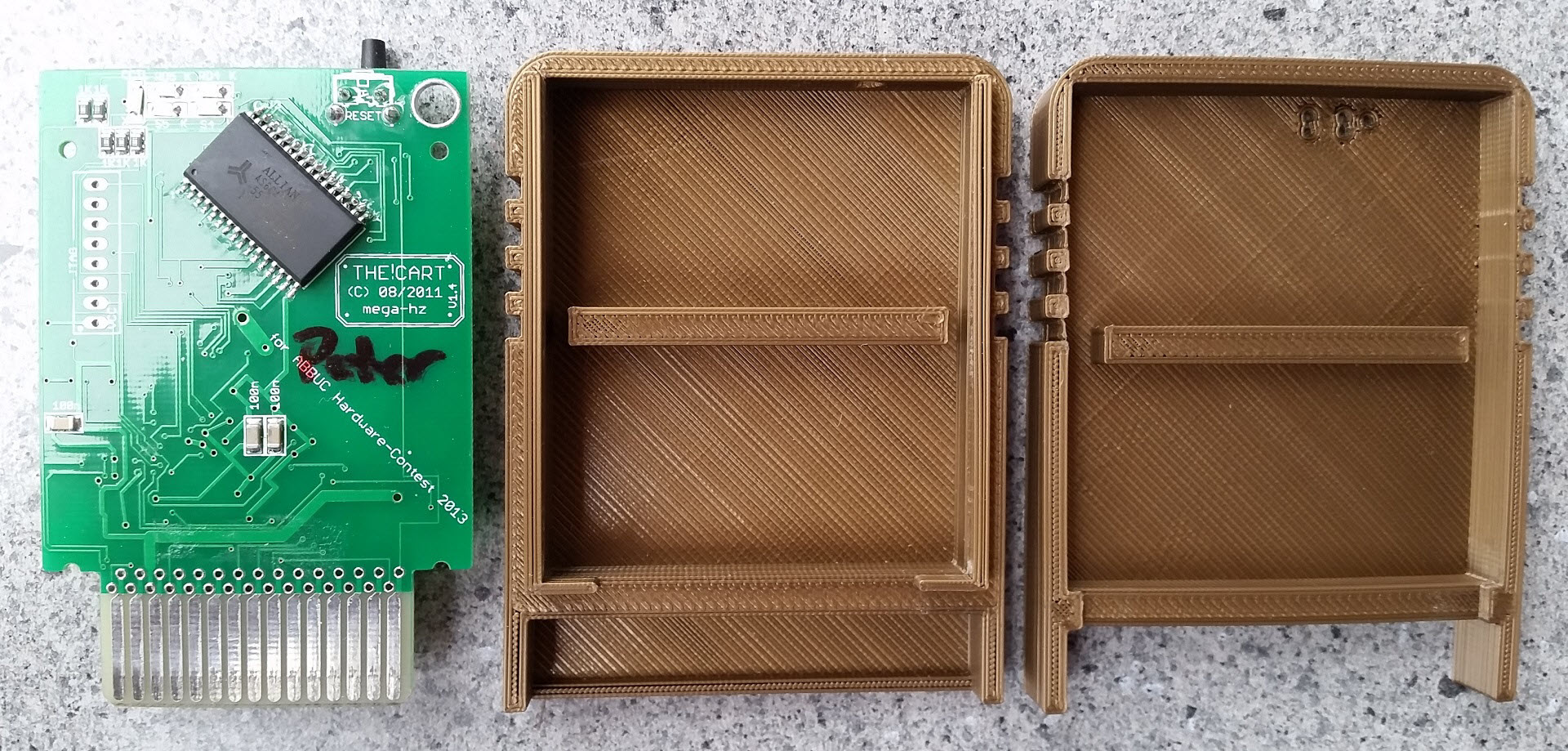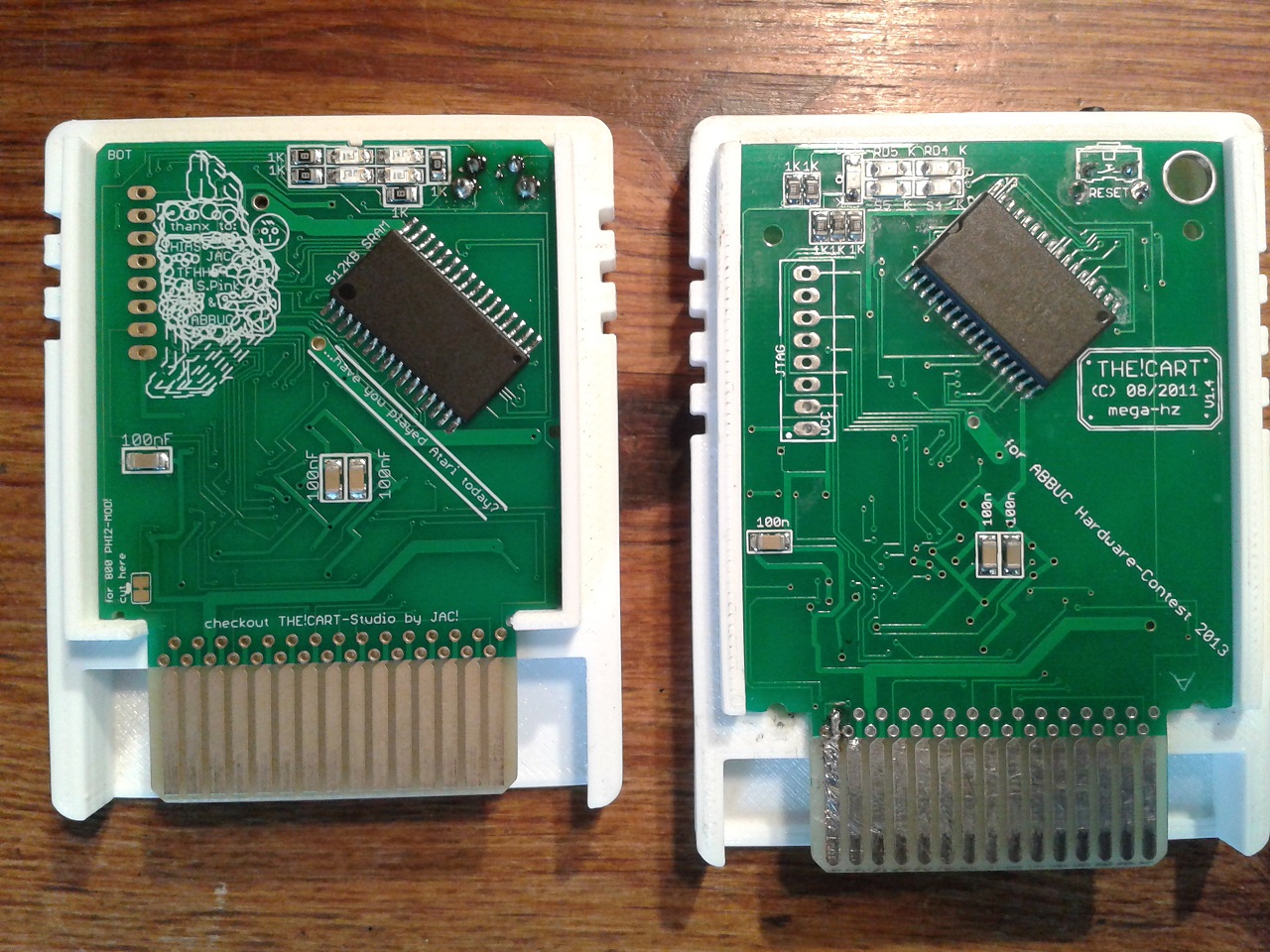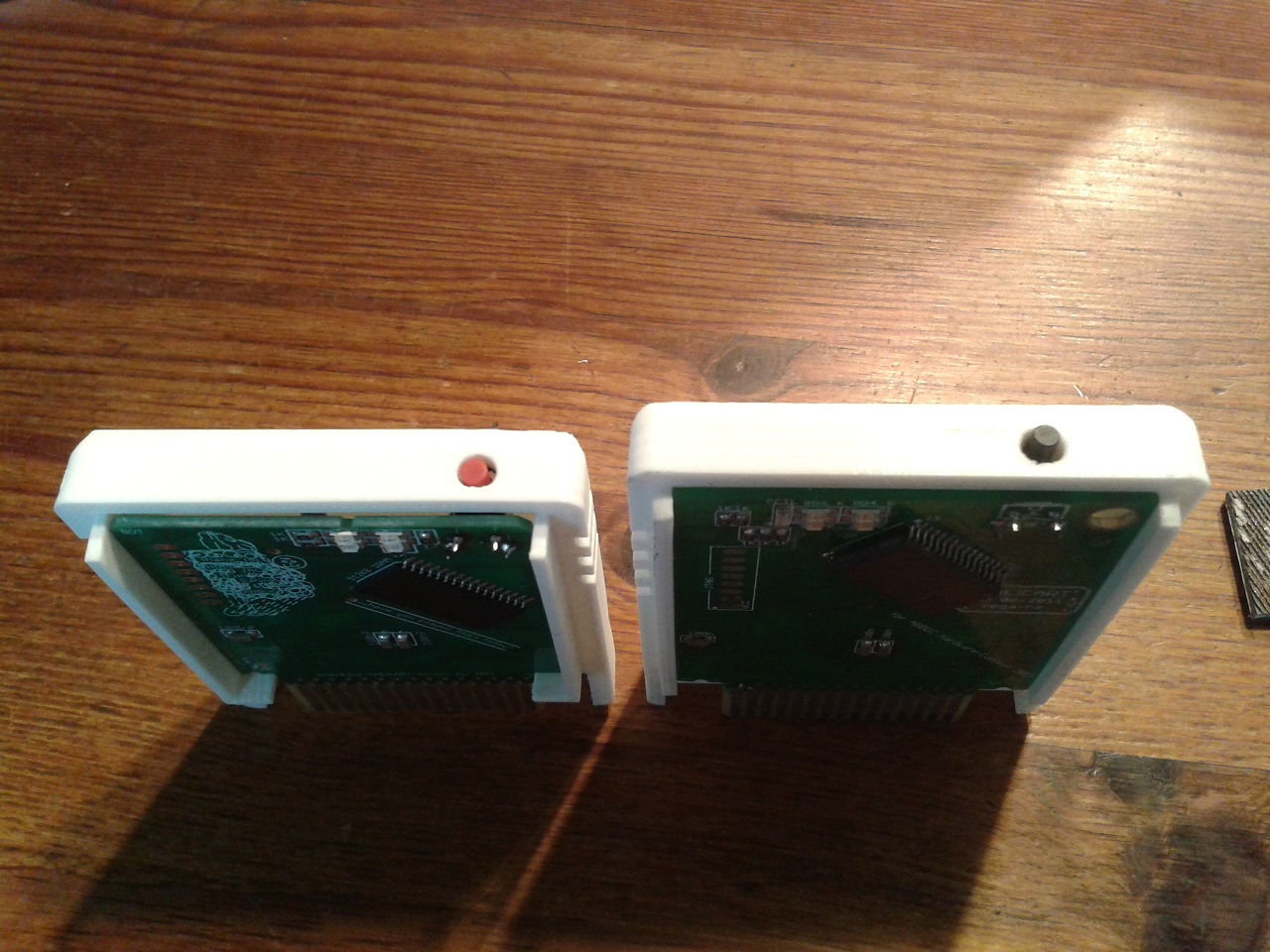In October 2013, a new flexible Atari 8-bit cartridge named "The!Cart" was released. Watch the video below to see what it can do. I support the project with documentation and video tutorials in this YouTube playlist. I also provide the "The!Cart Studio" software to create cartridge images of up to 128 MB and with files printing shells.
The!Cart - Features
At the beginning of the video game and home computer era, software was primarily released on cartridges. They had many benefits for the consumer:
- Simple to use - plug and play in the original sense of the phrase.
- No additional hardware, like a disk drive, was required. That was very important when a disk drive was several times more expensive than a computer.
- No loading was required; the program was instantly available when you powered the machine. Compared to disk or even cassette drives, cartridges are infinitely fast.
- No DOS or command line input is required.
Cartridges also had benefits for the software producer:
- Mass production using mask ROMs was cheap.
- Hardware is hard to duplicate with reasonable effort, so using cartridges inhibited piracy initially.
With the advent of inexpensive disk drives and disks, it all changed because it became more attractive for the software producer to release the software on disk. At least until the race between copy protection and crackers was lost. Nevertheless, all the benefits for the consumer are still highly desirable today. Besides that, there are software titles for which the original program is only available on cartridge, for example, OSS Action! or SpartaDOS X. Even new titles are sometimes released as cartridge-only versions, for example, Space Harrier and Atariblast. In most cases, these programs are cartridge-only because they leverage the possibilities of having several kilobytes up to megabytes of ROM space directly available to the programmer via bank switching. Many software producers in the 80ies even created individual cartridge hardware and bank switching schemes to fit their software requirements best.
And this is where "The!Cart" comes into play. The unique key feature of "The!Cart" is the hardware-level emulation of 35 different bank switching schemes. No other hardware can currently do that. Combined with the 128 MB of Flash ROM, you can put every ROM release for the Atari 8-bit computer on a single cartridge. Via the menu, with the Google-like search, you can easily find the correct entry in up to 15.000 ROM files and run the program instantly without any loading.
Besides the native emulation of ROM cartridges, including Atarimax Maxflash compilations, the menu system of "The!Cart" also supports emulating ATR disk image files as read-only disk drives. This way, you can run any disk-based program from "The!Cart", provided it does not need to write back to the disk. This disk image emulation puts "The!Cart" in the mass storage media category. I've compiled an overview of the most prominent mass storage media and their properties. This can help you compare and choose which fits best for you. The products on the SIO port can be combined with the cartridge slot-based products. Of course, I cannot put every detail into the overview. So, if you have further questions, post them in "The!Card" thread on AtariAge.
| Product | Atarimax Maxflash 8mbit |
The!Cart | Ultimate SD | SIDE | SIO2USB | SIO2SD |
|---|---|---|---|---|---|---|
| Producer | Atarimax | mega_hz | electroctrains | Lotharek | ABBUC | Lotharek |
| Plugs Into | Cartridge Slot | Cartridge Slot | Cartridge Slot | Cartridge Slot | SIO Port | SIO Port |
| Primary Storage Medium | Built-in Flash ROM | Built-in Flash ROM | External SD Card | External CF Card | External USB Stick | External SD Card |
| Natively Emulates | ROM Image | ROM Image | ROM Image | Hard Drive | Floppy Drive | Floppy Drive |
| Size | 1 MB | 128 MB | Up to 8 GB (FAT32) Up to 1 MB per ROM Image |
Up to 128 GB Separated into Partitions |
90k to 16 MB per Disk Image, Many Disk Images per USB Stick |
90k to 16 MB per Disk Image Many Disk Images per SD Card |
| Transfer Protocol | Direct Memory Mapping (8k) No Bank Switching Emulation |
Direct Memory Mapping (8k, 16K) Emulation of 35 Bank Switching Schemes |
Direct Memory Mapping (8k, 16K) Emulation of 38 Bank Switching Schemes |
Memory Mapping (8K) |
SIO |
SIO |
| Loading Speed | Instantly | Instantly | Very High | Very High | High (with SIO patch) | High (with SIO patch) |
| Menu System | Yes, it comes with Image Creation Software | Yes, it comes with Image Creation Software | Yes, it comes with a cartridge | Yes, it comes with DOS | Yes, it comes with DOS | Yes, it comes with DOS |
| Menu Entries | Up to 75 | Up to 15.000 | Up to 20000 per Directory, Multiple Directory Levels |
Depends on DOS | Depends on DOS | Depends on DOS |
| Supports XEX Files | Yes (Directly) | Yes (via AtariMax Emulation) | Yes (Directly) | Yes (Directly) | Yes (Directly) | Yes (Directly) |
| Supports ATR Files | Yes (Read-only Emulation) | Yes (Read-only Emulation) | No | No (Yes, together with U1MB) | Yes (Native) | Yes (Native) |
| Writeable from Atari | Yes | Yes | No | Yes | Yes | Yes |
| Writeable as File System | No | No | No | Yes | Yes | Yes |
| RAM Disk Driver | No | Yes (512 KB) | No | No | No | No |
| Estimated Price 2020 | 37 EUR | 75 EUR | 74 EUR | 55 EUR | 120 EUR | 74 EUR |
The!Cart - Questions and Answers
Where can I buy The!Cart?
- As of July 2020, a new batch of "The!Cart" is available in the ABBUC Member Shop for 75 EUR. To buy there, you must be registered in the ABBUC Forum, and your member ID must be associated with your user account. If that link is missing, just PM one of the ABBUC forum moderators.
Does "The!Cart" work with all Atari 8-bit computers?
- It has been tested successfully on Atari 400 (48k), Atari 600 XL, Atari 800 XL, Atari 1200 XL, Atari 130 XE, and Atari 65 XE.
- The cartridge slot lid on the Atari 400 and Atari 800 can only be closed with a new, smaller "The!Cart" (2017). If you have a "The!Cart" (2013), you must leave the lid open and somehow lock the power switch. In all other cases, the shells fit into the regular cartridge slots without problems.
- One problem that was found is an incompatibility with the Atari 800. This incompatibility is not specific to "The!Cart" but is due to a difference in the pin-out of the Atari 800's left cartridge slot compared to all other Atari 8-bit machines. The problem can be solved with a minimal modification that makes the Atari 800's left cartridge slot compatible with all other Atari 8-bit machines. Click Atari 800 Fix in the menu to read the details.
- One case was reported where an Atari 8000 XL with built-in U1MB didn't work correctly with The!Cart. As it turned out, the 74LS08 chip in the Atari is too slow when more expansions are on the bus. Exchanging it with a standard 74LF08 chip fixed the problem.
- One case was reported where an Atari 400 with a built-in Super Color CPU Card didn't work correctly with "The!Cart" (2017). As it turned out, the reason was the change in impedance caused by the board. Exchanging the SMD resistor marked with "5K6" on the "The!Cart" PCB with an 8K2 resistor fixed the problem.
Does "The!Cart" have gold-plated contacts?
- "The!Cart" (2013) did not have gold-plated contacts.
- "The!Cart" (2017) does have gold-plated contacts.
Does "The!Cart" support the right cartridge slot?
- The!Cart is designed for the left cartridge slot to work the same way in all Atari 8-bit computers. It does not work in the right slot of the Atari 800.
- It can emulate 8k right slot cartridges while plugging in the left cartridge slot of any Atari 8-bit computer, including the Atari 800. Note that the auto-start of right slot cartridges is only supported if the Atari computer uses OS-A or OS-B.
- Because "The!Cart" can only emulate one cartridge at a time, it is not possible to emulate a right slot cartridge (e.g., Monkey Wrench) and a left slot cartridge (e.g., ATARI BASIC) simultaneously. But this can be solved by putting both 8 KB ROM files into a single 16 KB ROM file and including that as a "Standard 16 KB" entry.
How limiting is it if you have SIO2USB or SIO2SD instead of SIO2PC for the transfer process?
- Everything is optimized for the best speed on whatever hardware you have.
- Transfer speed is the highest if you use SIO2PC with AspeQt or RespecQt (Version 5.3 does not work!). There, a single 128 MB ATR file is created. Both SIO emulators support up to POKEY divisor 0 with 8k sectors, and you can leave the whole thing unattended since no disk change is required.
- A filled "The!Cart" results in 9 ATR files. If you have one of the SIO2USB/SIO2SD devices, you can put as many ATR files in the virtual disk drives as the device supports. At least four are typically supported. If the SIO device supports SIO high speed, i.e., POKEY divisor 3 with 256 bytes sectors, the flasher will automatically use that.
- If only parts of the space are used, the flash skips the respective ATR files and sectors while loading.
How many floppy drives does the flasher support for reading the image data?
- The flasher software supports reading from up to 15 drives named "D1:...D9, DJ:-DO" like in SpartaDOS. At most, 9 ATR files are created, and you can put them in any of the available drives. If an ATR is not found in any disk drive, you will be prompted to insert it into one.
Is there a limit to how many times the Flash ROM can be flashed?
- According to the S29GL01 chip specification, 100,000 program-erase cycles are guaranteed.
Can all disk-based games be loaded?
- It is like emulating disk drives from ATR images and loading XEX that 100% compatibility cannot be reached without changing the operating system. The reason is that the loading must be somewhere in the RAM, and no matter where you put it - there will be one program to use precisely that memory area.
- The loader of "The!Cart" is compatible and allows on-the-fly patching for individual files if required.
- Besides, you can use the very good ATR and XEX loader provided with the Atari Maxflash Studio and put the resulting Maxflash image onto "The!Cart".
- With these options combined, "The!Cart" reaches almost 100% compatibility.
Can disk-based games like Ultima save their state on the cartridge?
- No. "The!Cart" is a cartridge emulation, not a drive emulation. You can load ATR files with the built-in loader, but they are read-only. Only the flasher program can alter the content on the cartridge.
Can disk-based programs use "The!Cart" as a RAM Disk?
- Yes. Besides the 128 MB of Flash ROM, "The!Cart" also contains 512 KB of RAM, which is used as buffer memory by the Flasher software and can be used as a regular RAM disk under DOS. See the separate page for The!RamDisk driver for details. Because the RAM on "The!Cart" is in the cartridge area like the Flash ROM, it is only usable by the driver. Programs that require Atari XE compatible extended memory inside the computer (controlled via PORTB of the PIA) will not see the RAM of "The!Cart" unless patched.
Which sizes are available?
- Originally three sizes (32 MB, 64 MB, and 128 MB) were available.
- Meanwhile, only the 128 MB version is available. Even the Spansion 128 MB flash chip (S29GL01GT**TF****, for example, S29GL01GP90TFI01) is increasingly hard to get as the world moves to serial flash ROMs.
What are RD4/5, S4/5, and CCTL, and what do the related LED lights mean to a less technical user?
- The LED lights indicate the status of the control signals on the cartridge ports. See the closeup for the position of the LEDs.
- CCTL indicates CPU access to the cartridge control area (bank switching continues). This LED is not present in the "The!Cart" V2 anymore.
- RD4/RD5 indicate that the computer currently does see the "The!Cart" and if it is seen as a lower 8k, upper 8k, or 16K cartridge.
- S4/S5 indicates CPU access to the cartridge's lower 8k / upper 8k.
What advantages do you feel "The!Cart" has over similar products?
- Ultra-fast Google-like search over up to 15.000 entries.
- Hardware-level emulation of 35 cartridge bank switching schemes.
- Compared to Atarimax Maxflash: Almost 128 times space, Atarimax Maxflash can also be emulated.
- Compared to Ultimate SD: Faster browsing and loading.
- Compared to any SIO or Harddisk-Emulation: Zero loading time for ROM software, practically unbeatable loading speed for disks.
- Built-in 512 KB of RAM are usable as RAM disk using The!RamDisk driver.
What are some areas you would like to improve?
- Software:
- Add support for directly loading XEX files without wrapping them into ATR disk images or Atarimax Maxflash cartridge images.
- Add support for directly playing SAP files. Imagine http://asma.atari.org on "The!Cart" with the Google-like search - it'd be like Spotify on the Atari :-)
What should an interested buyer of "The!Cart" know before purchasing?
- It's probably not the single solution you want. It is very convenient for gaming and other things like data exchange or saving stuff. It would be best if you still had a SIO2USB, SIO2SD, or similar in parallel.
- No ROM emulating solution (Atarimax Maxflash, "The!Cart", Ultimate SD) can technically be 100% compatible with all SIO-based disk software. Yet here, "The!Cart" is the best level of compatibility.
- "The!Cart" is shipped without a shell to keep the price low. You can print your shell based on the 3D models provided below.
The!Cart V1 Shells
The original "The!Cart" was delivered with a cheap shell to keep the price low. Sven Pink from the ABBUC created the first version of a new 3D-printed shell 2015, but it was never officially released. Only one prototype was printed back then, which I own. Click on the images to see them in full resolution.
Sven lacked the time, and I lacked the skills and equipment to continue the design. So I decided to release the files in 2016 in their current state. Then Bernhard obtained his 3D printer and started improving the models and creating shells.
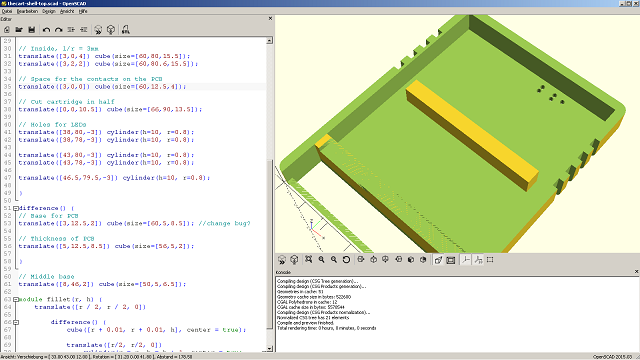
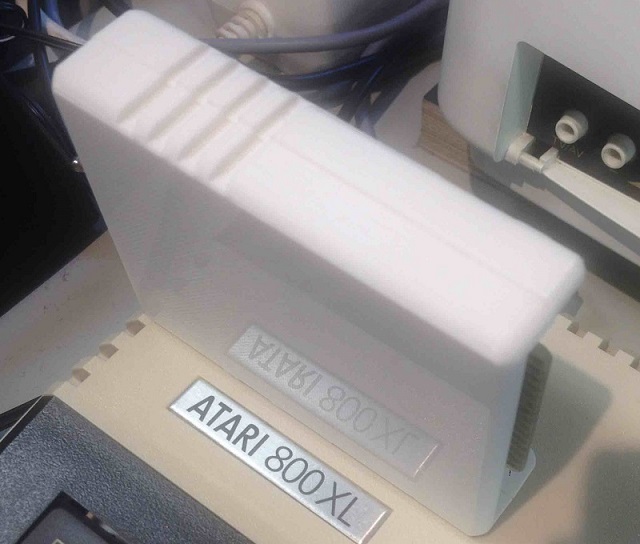
Click here to download the OpenSCAD (".scad") and stereolithography (".stl") files for printing your shell for the first version of "The!Cart". If you get usable results and maybe create improved versions of the model, I'd be happy to add pictures of your shells here and update the download accordingly. You can also visit the corresponding "The!Cart" Shell thread on AtariAge for questions and feedback. Here's the video on how to move the PCB from the old shell into a new 3D-printed shell.
The!Cart V2 Shells
For the second version of "The!Cart" we provided a 3D print shell from the beginning. Click here to download the OpenSCAD (".scad") and stereolithography (".stl") files for printing your shell. You can also visit the corresponding "The!Cart" Shell thread on AtariAge for questions and feedback.
The V2 PCB is smaller than the V1 PCB, and so is the shell. The V2 PCB also comes with fully gold-plated contacts.
The!Cart V2 completely fits into an Atari 400 and Atari 800, so the lid can be closed. The pictures below show the V2 shell on the left and the V1 shell on the right.
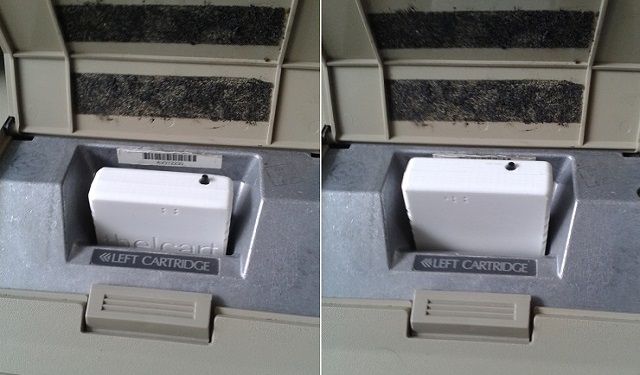
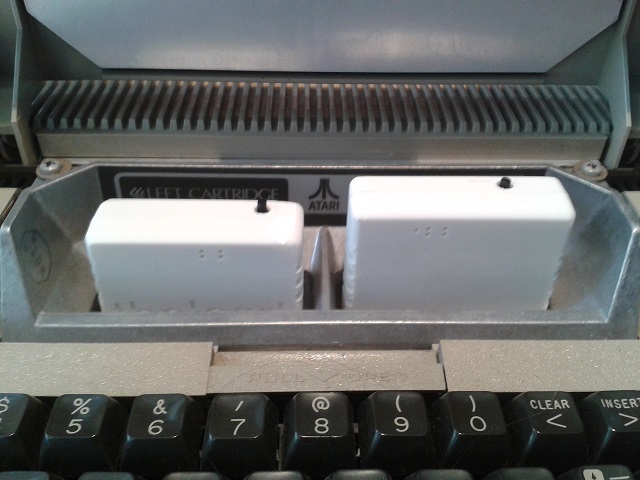
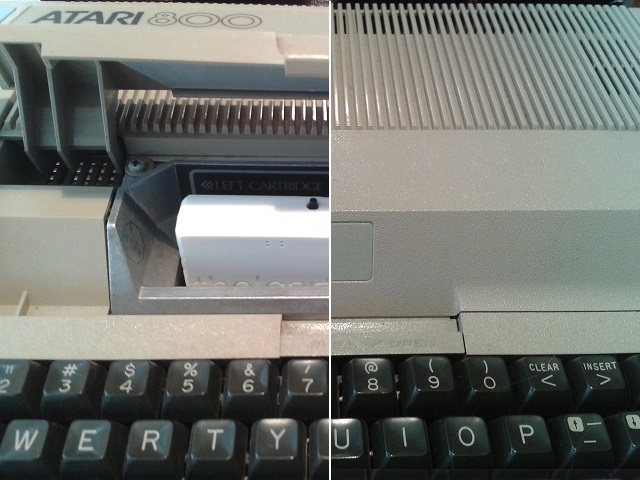
And for those who still prefer the classic Atari-800-style shell, I recommend looking at Wolfsoft's blog. The "CX4042" label for that mod and the other two shell labels provided by Mr. Robot are included in the shell download.
